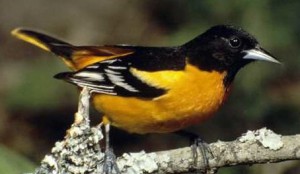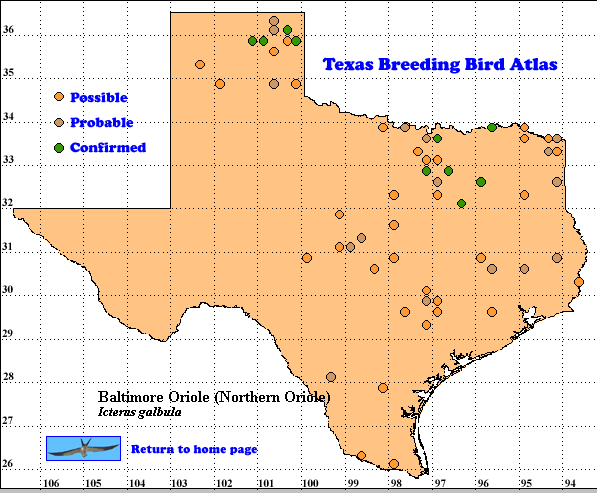Baltimore Orioles breed in a limited area of Texas (see map), but pass through the state, mostly east of the 100th meridian, on both spring and fall migration. In winter they are casual on the lower Gulf Coast (Oberholser 1974).
After being recognized since the time of Linnaeus as a distinct species, Baltimore Oriole was lumped with Bullock’s Oriole (I. bullockii) in 1983 into a single species, the unfortunate “Northern Oriole,” because the two species hybridize on the western Great Plains in Kansas and Nebraska. Study of their genetic materials revealed the two species are not closely related, and study of the zone of hybridization found it stable, so in 1998, these two species were again recognized as distinct.
Males in adult plumage are easily differentiated from Bullock’s Oriole, but females and immatures require experience and careful study to distinguish. Males do not acquire adult plumage until after their second summer. Although they are capable of breeding in their second summer while still in a female-like plumage, many do not acquire mates during this season (Rising and Flood 1998).
DISTRIBUTION. During the 1987-1992 field work of the TBBA project, breeding Baltimore Orioles were found by atlasers in the area south of the Red River, north of the 32nd parallel and east of the 98th meridian, and in the northeast corner of the Panhandle. The possible reports from outside these areas may represent late migrants or non-breeding wanderers. Data from the Breeding Bird Survey (BBS, Sauer et al 2004) are consistent with this interpretation.
In eastern North America, Baltimore Orioles breed most commonly north of the Mason- Dixon line as far north as southern Ontario and Quebec. The range on the Great Plains extends north from Texas to Nebraska; another portion extends from Wisconsin, Minnesota and North Dakota northwestward through Manitoba, Saskatchewan and Alberta to northeast British Columbia (Sauer et al. 2004).
Baltimore Orioles may wander outside their usual breeding range; Oberholser (1974) reported a pair nesting in El Paso in 1959, a region where they are rare or casual as migrants.
SEASONAL OCCURRENCE. Baltimore Orioles have been found in Texas as early as March 9, but the bulk of the northbound migrants pass through from mid-April to early May and the latest date for the end of northbound migration is June 29, only a few days before the earliest date for southbound migration, July 4. Most fall migration occurs from late August to early October. Oberholser (1974) also lists a few winter records.
The breeding season for this species is relatively short and the periods of north and southbound migration nearly overlap. Sorting out breeders from late spring or early fall migrants requires diligent work by observers.
BREEDING HABITAT. Baltimore Oriole is an adaptable species, breeding in open deciduous woodlands, including riparian situations, residential areas and parks. In Texas, it prefers cooler, moister habitats.
The nest is placed 1.2-27 m (4-90 ft) above ground in a tree or bush and is a remarkably close-woven, pensile basket, much deeper than wide. The nest is usually placed near the end of a horizontal or nearly horizontal branch, often with the rim attached to a forked twig.
The female weaves tough grasses, strips of bark, and other materials, including human detritus. She takes as long as 2 weeks to complete the task. The nest is lined with plant down and other soft materials and is built strongly enough that some last through two winters.
The usual clutch is 4 or 5 eggs, with a range of 3-7 (Oberholser 1974). The female incubates for 11 days and the young remain in the nest about 2 weeks (Rising and Flood 1998).
STATUS. The breeding status of Baltimore Oriole in Texas is not encouraging. Lockwood and Freeman (2004) report this species as a common migrant in the eastern half of the state, but as a locally uncommon summer resident of the eastern third of the Panhandle and rare to uncommon and local in north-central Texas. The TBBA map suggests the breeding range of this species is quite limited geographically.
BBS data show observers found an average of one oriole or less per 40 km (25 mi) route in Texas with a slightly higher density in the extreme northeast corner of the Panhandle (Sauer et al. 2004). In contrast, several routes in Kansas and Nebraska, averaged 36-50 Baltimore Orioles per route (Price et al. 1995).The range of Baltimore Oriole in Texas may not have changed greatly since 1972. Edgar Kincaid (in Oberholser 1974, p. 824) noted a drastic decline of this species as a breeder in Texas since the 1920’s and by 1972 it was “practically out of the nesting business” in Texas. He suggested this decline may have been due to a trend to warmer and drier weather in the state.
Kincaid’s suggestion is consistent with recent computer modeling of the effects of global warming on bird populations. These paint a dismal picture for this species in Texas. Projections by the American Bird Conservancy suggest when atmospheric concentrations of carbon dioxide reach a level double that of pre-industrial times, perhaps in 50-100 years, Baltimore Orioles will not breed closer to Texas than northern Iowa (Line 2003).
While the range of Baltimore Oriole in Texas may not have changed noticeably between 1972 and 1992, BBS trend data suggest a continuing
population decline in the period 1966-2003. The 11 BBS routes in Texas which consistently reported Baltimore Orioles produced a 95% confidence interval of -6.2 to +0.4 % population change per year (There is a 95% probability that the actual value of the average annual change will fall between these two values, Sauer et al. 2004).
The limited number of confirmed breeding sites (10) found by TBBA atlasers is also consistent with this bleak picture of Baltimore Oriole as a very limited breeder in Texas. Data from the 1794 BBS routes in the United States and Canada reporting this species produced a statistically significant population trend of -0.7% per year, suggesting Baltimore Oriole will continue to be a common migrant in Texas long after it disappears as a breeder in this state. Text by Robert C. Tweit (2004)
Literature cited
Line, L. 2003. Silent Spring, a sequel? National Wildlife 41(1): 20-23.
Lockwood, M. W. and B. Freeman. 2004. The TOS handbook of Texas birds. Texas A&M University Press, College Station.
Oberholser, H. C. 1974. The bird life of Texas, Vol. 2. University of Texas Press, Austin.
Price, J., S. Droege, and A. Price. 1995. The summer atlas of North American birds. Academic Press, New York.
Rising, J. D., and N. J. Flood. 1998. Baltimore Oriole (Icterus galbula). In The birds of North America, No. 384 (A. Poole and F. Gill, eds.). The Birds of North America, Inc., Philadelphia, PA.
Sauer, J. R., J. E. Hines, and J. Fallon. 2004. The North American Breeding Bird Survey, results and analysis 1966-2003. Version 2004.1. USGS Patuxent Wildlife Research Center, Laurel MD (Web site, http://www.mbr-pwrc.usgs.gov/bbs).

